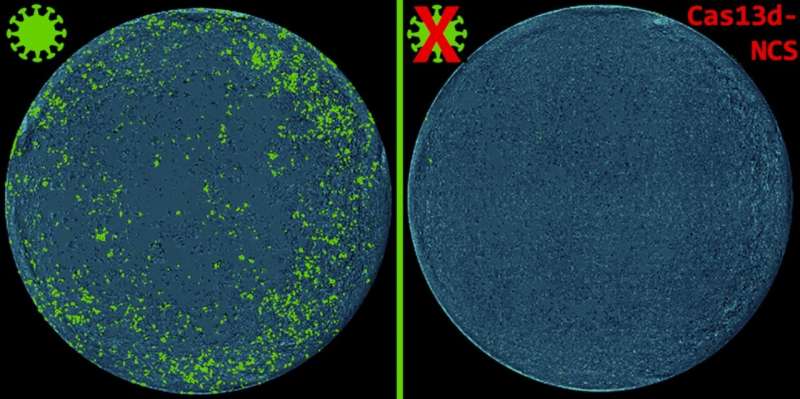
The rise of RNA viruses like SARS-CoV-2 highlights the need for new ways to fight them. RNA-targeting tools like CRISPR/Cas13 are powerful but inefficient in the cytoplasm of cells, where many RNA viruses replicate.
Scientists from Helmholtz Munich and the Technical University Munich (TUM) have devised a solution: Cas13d-NCS. This new molecular tool allows CRISPR RNA molecules that are located within the nucleus of a cell to move to the cytoplasm, making it highly effective at neutralizing RNA viruses.
This advancement opens doors for precision medicine and proactive viral defense strategies. The findings were published in Cell Discovery.
As the world prepares for future and ongoing global health threats from RNA viruses such as the SARS-CoV-2 pandemic, breakthrough advances in antiviral development are becoming a critical weapon in the fight against these infectious diseases.
At the heart of this innovation is the exploration of CRISPR/Cas13 systems, which are known for their programmable capabilities to manipulate RNAs and have become indispensable tools for various RNA targeting applications. However, a significant obstacle has hampered the effectiveness of Cas13d: its restriction to the nucleus of mammalian cells. This drastically limited its utility in cytosolic applications, such as programmable antiviral therapies.
A potent antiviral solution
A research team led by Prof. Wolfgang Wurst, Dr. Christoph Gruber and Dr. Florian Giesert (Institute of Developmental Genetics at Helmholtz Munich and Chair of Developmental Genetics at TUM), which collaborated with the teams of Dr. Gregor Ebert (Institute of Virology at Helmholtz Munich and at TUM) and of Prof. Andreas Pichlmair (Institute of Virology at TUM), successfully overcame this challenge associated with the cytosolic inactivity of Cas13d.
Through careful screening and optimization, the researchers developed a transformative solution: Cas13d-NCS, a novel system capable of transferring nuclear crRNAs into the cytosol. crRNAs, or CRISPR RNAs, are short RNA molecules that guide the CRISPR-Cas complex to specific target sequences for precise modifications. In the cytosol, the protein/crRNA complex targets complementary RNAs and degrades them with unprecedented precision.
With remarkable efficiency, Cas13d-NCS outperforms its predecessors in degrading mRNA targets and neutralizing self-replicating RNA, including replicating sequences of Venezuelan equine encephalitis (VEE) RNA virus and several variants of SARS-CoV-2, unlocking the full potential of Cas13d as a programmable antiviral-tool.
Redefining the landscape of RNA virus therapeutics
This important achievement represents a significant step towards combating pandemics and strengthening defenses against future outbreaks. The impact of the study goes beyond traditional antiviral strategies and CRISPR systems and ushers in a new era of precision medicine by enabling the strategic manipulation of subcellular localization of CRISPR-based interventions.
“This breakthrough in antiviral development with Cas13d-NCS marks a pivotal moment in our ongoing battle against RNA viruses,” says Prof. Wolfgang Wurst, coordinator of the study. “This achievement showcases the power of collaborative innovation and human ingenuity in our quest for a healthier and more resilient world.”
More information:
Christoph Gruber et al, Engineered, nucleocytoplasmic shuttling Cas13d enables highly efficient cytosolic RNA targeting, Cell Discovery (2024). DOI: 10.1038/s41421-024-00672-1
Provided by
Helmholtz Association of German Research Centres

READ MORE
Successful development of the world’s first superconducting wide-strip photon detector
Developed Superconducting Wide-Strip Photon Detector (SWSPD). Credit: National Institute of Information and Communications Technology (NICT) [...]
7 Bizarre Spa Treatments
© Ryan M. Bolton/Shutterstock.com Mankind’s relentless pursuit of physical beauty is nothing new (the use [...]
The Complicated History of the Human and Elephant Relationship
A new exhibition featuring rare books from the Smithsonian Libraries examines the complex history and [...]
Enhanced superconductivity in monolayer FeSe films on SrTiO₃(001) via metallic δ-doping
Fig. 1 The transport results of FeSe/δ-doped SrTiO3(001), in comparison with FeSe/SrTiO3(001). Credit: Science China [...]
Prehistoric Birds May Have Used Four Wings to Fly
A fossil of a prehistoric bird from the enantiornithine genus shows feathers on its hind [...]
High-efficiency formamidinium-based perovskite solar cells with operation lifetime over 2000 hours
The researchers used a powder engineering method to create a high-quality version of FAPbI3. First, [...]
Balancing Homework and A.P. Classes, These High Schoolers Discovered Four Exoplanets
An artist’s rendering of the five-planet system that orbits star HD 108236, or TOI-1233. In [...]
Advances in topological phase transition in organometallic lattices
Lactam-lactim tautomerization induces topological phase transition. Credit: Li et al. A research group led by [...]